Strange lake belches flammable gas in the high Arctic
Lake Esieh is spewing vast amounts of methane — a potent greenhouse gas
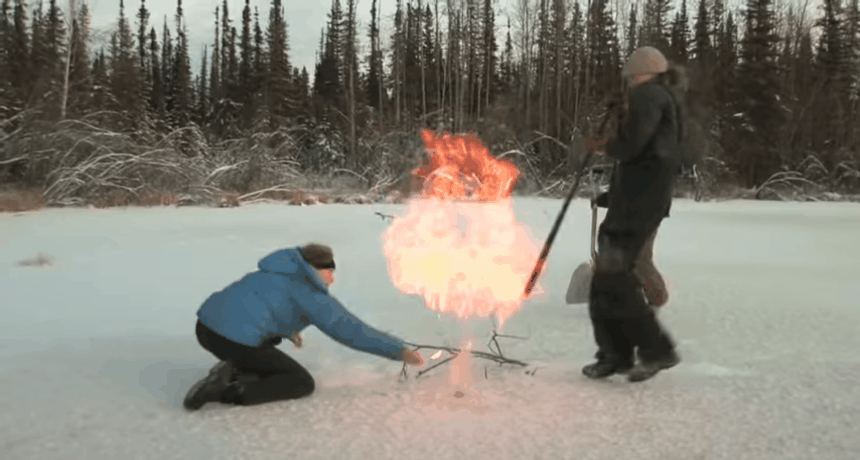
Methane, a highly flammable gas, gets trapped under the ice of some Arctic lakes in winter. If a hole is punched through the ice, the escaping gas can be lit into a fireball.
University of Alaska Fairbanks
By Douglas Fox
September 8, 2017, was an exciting date for Katey Walter Anthony. On this cool, windless evening she first visited Alaska’s Lake Esieh. Few people visit this remote stretch of wilderness. It is covered in tundra and scraggly spruce trees. Thousands of lakes dot the region. But Walter Anthony quickly realized that this lake was strange. As her boat glided across it, she came to a place where the water seemed to be boiling.
The water wasn’t warm. But it roiled and fizzed. Bubbles of all sizes streamed up, popping at the surface. One bubble, as large as a softball, gave off a loud bloonk as it ruptured. The bubbles covered a swath of the lake larger than a football field. And they rose with such force that they slowly pushed her boat to the side.
Walter Anthony leaned over the edge of the boat and collected some bubbles in a bottle. Then she struck a match and opened the bottle to release the gas she had just collected. The gas caught fire!
The yellow-tipped flame that danced over the bottle confirmed her suspicion. It showed that the lake was gurgling out a flammable gas, called methane. Each molecule (CH4) contains one atom of carbon bonded to four atoms of hydrogen.
As a potent greenhouse gas, methane can absorb radiation from the sun, warming the atmosphere. Methane, along with carbon dioxide, is a major source of global warming. Later calculations would show that this little lake was belching out lots of this gas — some 2,000 kilograms (4,400 pounds) each day.
Walter Anthony works at the University of Alaska in Fairbanks. She’s a limnologist, a scientist who studies lakes. To date, she has studied more than 300 of them in the Arctic. Many give off methane. But Lake Esieh was different. She could hear a deep-throated gurgling as bubbles shoved their way up, violently, through the mud at the bottom of the lake. “The sound was really amazing,” she says. It was coming from deep below her boat. “I’d never heard that before.”
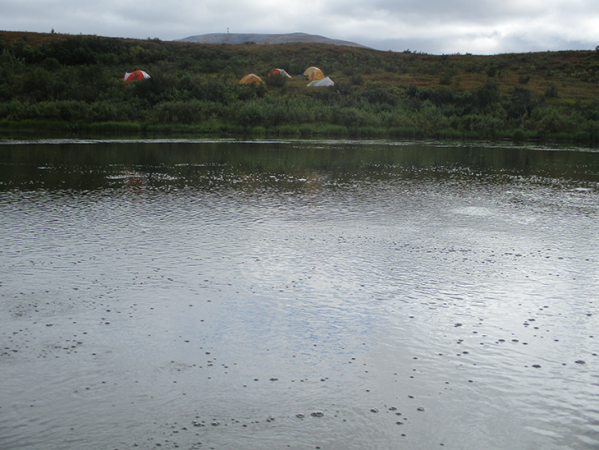
Scientists believe that the Arctic could release large amounts of methane over the next 100 years. The gas is naturally released as frozen soil, called permafrost, warms up and thaws. And some scientists worry that this methane will cause the world to warm more quickly than they had predicted.
Walter Anthony has spent nearly 20 years trying to understand this threat. She is trying to measure how much methane is coming out of warming Arctic lakes. And to her, Lake Esieh could be a warning. If other lakes respond the same way, the Arctic could be poised to burble out far more methane than anyone had expected. “We don’t even know how much gas is down there,” she says. “It’s a wild card.”
For that reason, it’s important to understand what’s happening at Lake Esieh.
Rotting mush
Permafrost covers 22 million square kilometers (8.5 million square miles) of territory across the north of Alaska, Canada, Europe and Asia. That’s an area larger than the United States and Canada combined. This frozen soil is rich in organic matter — the remains of plants that lived hundreds or thousands of years ago.
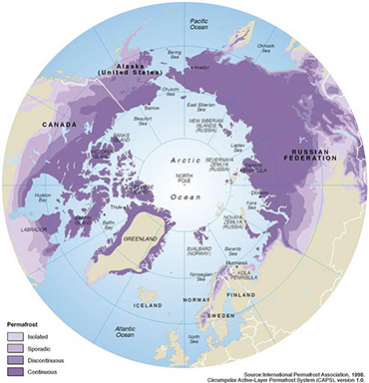
These dead plants froze before they could fully decay. But as that permafrost now thaws, single-celled microbes have begun dining on those plant remains. They break down the dead stuff into mush, like kitchen scraps in a compost heap. Along the way, the microbes exhale methane and another carbon-based gas, carbon dioxide (CO2).
Scientists have long known that melting permafrost would release these gases. What has not been clear is how much might come out and how quickly. People are especially concerned about methane. Over a period of 100 years, it absorbs more than 20 times as much heat, gram for gram, as carbon dioxide does. Once in the atmosphere, methane slowly turns into carbon dioxide — also a greenhouse gas.
Walter Anthony has been figuring out just how much methane Arctic lakes are spewing. She started in 2002, while she was working toward her PhD at the University of Alaska. Back then, she was spending much of her time in Siberia, in northeast Russia.
Thawing permafrost can make the ground sag. These low spots fill with water — forming what are called “thermokarst” lakes. Walter Anthony saw tiny bubbles of methane bubbling up as she paddled her boat across one of these Siberian lakes, called Shuchi. But she could never anticipate where a bubble would emerge. So she couldn’t catch or measure them.
Starry sky
She got some advice from an ecologist at the Northeast Science Station in Chersky, Russia. This Sergey Zimov suggested that she try a new approach: Wait until winter freezes the lake over. The ice might trap methane bubbles, showing her where the gas was accumulating.
In October 2002, she donned a down jacket and headed out into the cold. She shoveled snow off a strip of lake ice, then poured water onto it. This smoothed the ice so that she could see through it into the lake below.
“It was like looking at a starry night sky,” she says. The white gas bubbles stood out against the dark background of the water below. For the first time, she realized that most of the bubbles were coming up in very specific places — and always the same places. Now she knew where those places were.
She used a crowbar to chip holes in the ice. (She had the help of a large fellow named Dmitri Draluk, who also worked as a local firefighter, preacher and bodybuilder.) She and Draluk inserted bottles, with upside down funnels, to collect the gas that was bubbling up. They kept the bubble traps in place even after the ice melted.
After a year of catching bubbles, Walter Anthony could finally calculate how much methane had been bubbling up. And the results, she says, left her “very surprised.”
Scientists had thought that most methane seeped up without forming bubbles. They believed the bubbles held only a little of the gas. But Walter Anthony found that the bubbles held far more methane than what was seeping out other ways. And because scientists had missed those bubbles, they had underestimated how much methane the lakes were belching.
Positive feedback
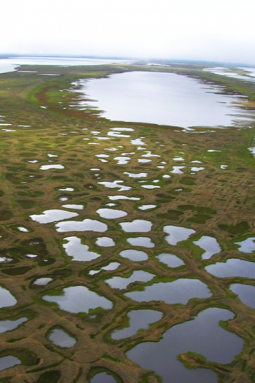
Thousands of thermokarst lakes dot the surfaces of Siberia, Alaska and Canada. If Walter Anthony’s measurements hold true for them all, then these lakes could be burping out five times as much methane as people had thought.
“This was certainly a breakthrough,” says David McGuire. “It gave us a much better idea about the importance of thermokarst lakes.” He’s a permafrost scientist who also works at the University of Alaska in Fairbanks.
Once a thermokarst lake has formed, the permafrost beneath can now thaw much more quickly. This is partly because the darker lake absorbs more sunlight than will frozen soil. Walter Anthony and her collaborators estimate that this boost in thawing could cause Arctic permafrost to release twice as much carbon by 2100 as people had predicted. (This “carbon” includes both methane and carbon dioxide.) That, in turn, could cause more warming, more permafrost thawing — and then even more greenhouse gases to be released.
Scientists call this vicious cycle a positive feedback. Some estimates suggest that by 2100, the positive feedback from thawing permafrost could add up to an extra 0.3° Celsius (0.54° Fahrenheit) of global warming.
That may not sound like much. But it could make a big difference if people still hope to keep the Earth from warming more than another 1.5 °C (2.7 °F).
Methane levels in the Earth’s atmosphere have more than doubled since 1700, from fewer than 700 parts per billion to more than 1,800 parts per billion. Most methane comes from human activities such as natural gas drilling, raising cows, the decay of dumped garbage and the intentional burning of forests and cropland.
Graph: 2 Degrees Institute
“It’s sort of like a headwind,” says Steve Frolking. He is a climate scientist at the University of New Hampshire in Durham. “It’s just going to make everything harder,” he says. It would mean people will have to reduce their emissions of greenhouse gases by even more.
But even these predictions of carbon-based gases being belched by permafrost don’t take into account the magnitude of methane emerging from Lake Esieh. And Walter Anthony has only just started studying that lake.
Hot spots
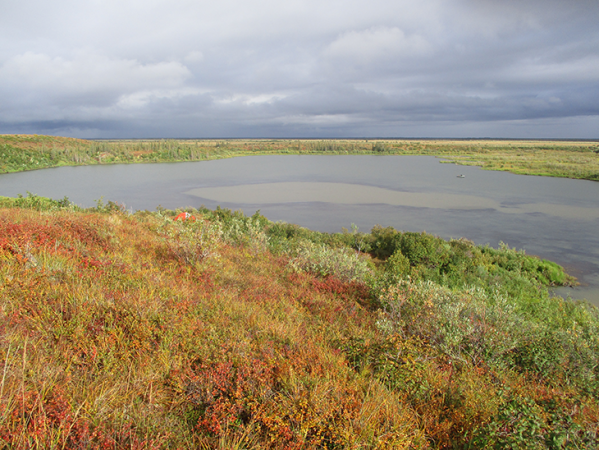
Two members of her team first spotted Lake Esieh from an airplane in April 2017. During several days of flying, they passed over hundreds of lakes. Most were still covered in winter ice. But Melanie Engram and Allen Bondurant noticed that one lake had two large dark spots free of ice. They surmised that these were “hot spots” — regions where gas was bubbling up quickly enough to keep any ice from forming.
Walter Anthony first visited the lake five months later. With a graduate student, her husband and their two young sons, she climbed into a boat and motored four hours up a river to reach the lake. Once there, it was easy to find the methane hot spots.
Paddling a kayak into the bubbling areas was actually “a little bit scary,” says Janelle Sharp, the graduate student on that trip. Not exactly frightening — but strange. “It’s like the water is boiling,” she says. “The bubbles that come up are as big as your head.”
Walter Anthony and her team returned to Lake Esieh in May 2018. They camped on a hillside overlooking one of the bubbling spots. Sharp boated around the lake using sonar, or pulses of sound, to map its bottom. Most of the lake was only about a meter (3 feet) deep. But beneath each hot spot, she found a deep crater in the lake bottom. One of them plunged to a depth of 15 meters (49 feet).
Crumbling hill
Walter Anthony, Sharp and several others returned to the lake again in August 2018. On arriving, they saw new evidence of the permafrost’s relentless thaw. The hillside where they had camped three months earlier was crumbling. Muddy cracks had opened in the ground. Blocks of soil up to 1.5 meters (5 feet) thick had slid off the hillside.
During that trip, Frédéric Thalasso made the first precise gas measurements. He’s a limnologist at the National Polytechnic Institute in Mexico City. He has visited plenty of Arctic lakes with Walter Anthony over the years. He was shocked to find that this one was giving off methane 100 times faster than most others he had seen.
Walter Anthony dated the age of the methane’s source by measuring radioactive carbon-14 in the gas. Carbon-14 builds up in plants while they are alive. After the plants die, their carbon-14 slowly decays into nitrogen. Scientists know how quickly carbon-14 disappears. So by measuring how much of it is left, they can figure out how long ago the plants that collected it had lived.
Walter Anthony’s carbon-14 measurements showed that the methane in Lake Esieh was coming from a very old source. These were rotting plants that had died at least 40,000 years ago — and maybe even millions of years earlier.
She now thinks that the microbes making this methane are eating some sort of fossil fuel. They might live in a coal bed (made of ancient plants) buried somewhere under the lake — below even the permafrost.
That methane would have seeped up through cracks in the rock — until it hit the permafrost above it. The gas couldn’t pass through this frozen barrier. So it collected underneath the frozen soil for tens of thousands of years.
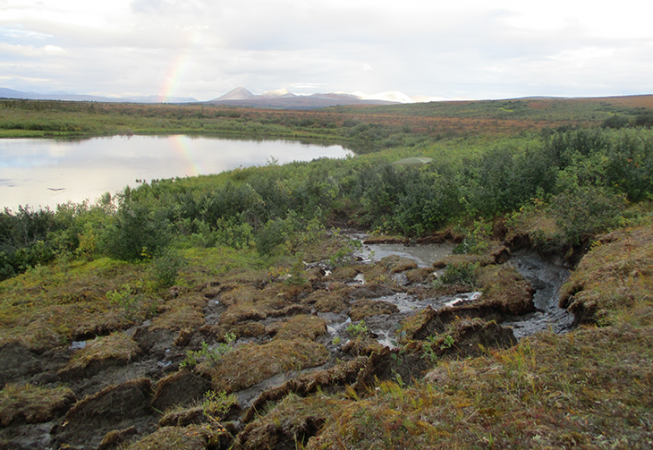
Big boom
This likely changed when the permafrost under Lake Esieh melted all the way to its bottom, Walter Anthony now believes. Suddenly all of that bottled-up methane had a way to escape.
The gas may have burst out violently at first. She says this would explain the two deep craters in the bottom of the lake. If that’s true, then Lake Esieh may not be the only place this has happened.
Scientists have found even larger craters in the permafrost of Siberia. One, discovered in 2014, is 50 meters (about 160 feet) deep. The explosion that ripped this hole in the ground threw chunks of dirt up to 125 meters (400 feet) away. Not everyone agrees on what caused the explosions. But one idea is that they were triggered by methane bursting out from below.
Evidence for similar methane explosions shows up in craters on parts of the Arctic seafloor north of Norway. Found two years ago, some span a kilometer (0.6 mile) across.
What’s important is that some of this methane is coming from a source that scientists had not counted yet. When scientists talk about permafrost carbon, they mean the dead plants buried within the permafrost, which microbes will turn into methane and carbon dioxide.
But Lake Esieh’s methane may have come from an even deeper source, one below the permafrost. And if that’s true, melting permafrost could release far more methane than scientists had suspected.
Big question
Walter Anthony’s discovery at Lake Esieh is “really interesting and fascinating,” says Frolking. He points out that this lake might turn out to be a freak event — the only one of its kind. Methane burping out of a single lake wouldn’t be nearly enough to change the world’s climate.
But if other lakes start acting the same way? “Then it matters a lot,” he says. “It’s huge.”
And Walter Anthony fears this could be the case. Methane may sit trapped under permafrost throughout the Arctic, she says. Much of it comes from deeply buried fossil fuels. The gas would have slowly accumulated for as long as the permafrost was there to stop its rise. In some places, that could be more than a million years.
The question is whether that gas will lead to more lakes like Esieh.
“As permafrost thaws and becomes more like Swiss cheese,” says Walter Anthony, “it’s logical to think we’re going to see more and more of these.”







